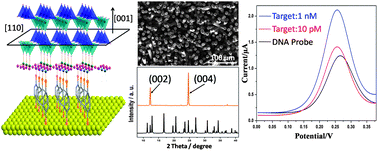A highly oriented hybrid microarray modified electrode fabricated by a template-free method for ultrasensitive electrochemical DNA recognition†
Abstract
Highly oriented growth of a hybrid microarray was realized by a facile template-free method on gold substrates for the first time. The proposed formation mechanism involves an interfacial structure-directing force arising from self-assembled monolayers (SAMs) between gold substrates and hybrid crystals. Different SAMs and variable surface coverage of the assembled molecules play a critical role in the interfacial directing forces and influence the morphologies of hybrid films. A highly oriented hybrid microarray was formed on the highly aligned and vertical SAMs of 1,4-benzenedithiol molecules with rigid backbones, which afforded an intense structure-directing power for the oriented growth of hybrid crystals. Additionally, the density of the microarray could be adjusted by controlling the surface coverage of assembled molecules. Based on the hybrid microarray modified electrode with a large specific area (ca. 10 times its geometrical area), a label-free electrochemical DNA biosensor was constructed for the detection of an oligonucleotide fragment of the avian flu virus H5N1. The DNA biosensor displayed a significantly low detection limit of 5 pM (S/N = 3), a wide linear response from 10 pM to 10 nM, as well as excellent selectivity, good regeneration and high stability. We expect that the proposed template-free method can provide a new reference for the fabrication of a highly oriented hybrid array and the as-prepared microarray modified electrode will be a promising paradigm in constructing highly sensitive and selective biosensors.


 Please wait while we load your content...
Please wait while we load your content...